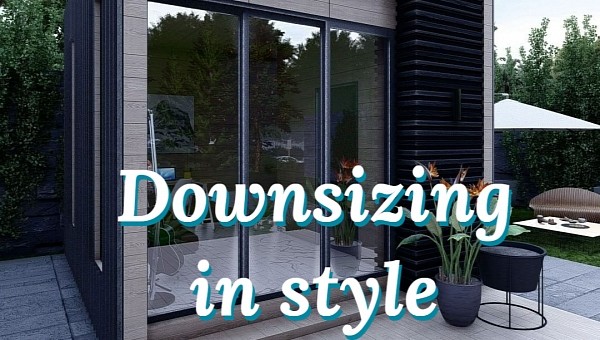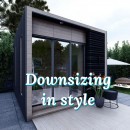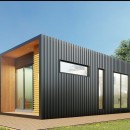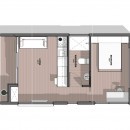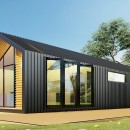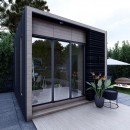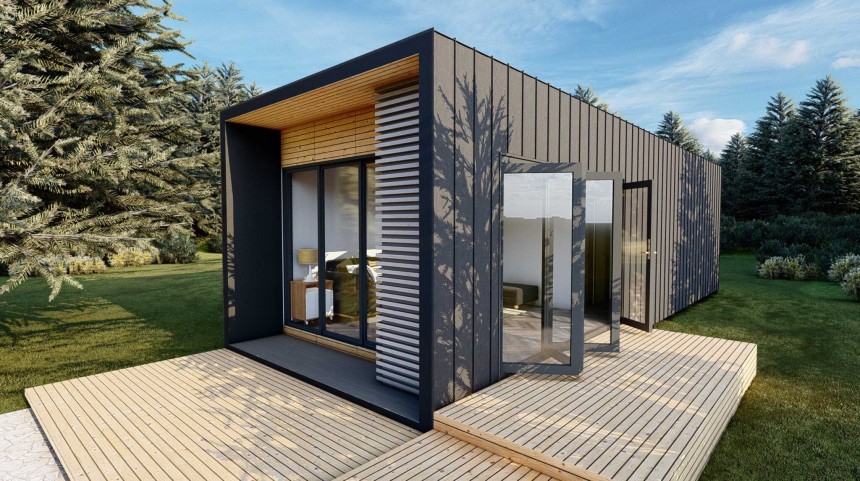Not that this would come as shocking news to anyone with eyes and a decent Internet connection, but downsizing is IN right now. It’s been so for the past two decades, with a spike over the past three years, and it’s not showing any signs of slowing down.
Given the recent boost in popularity, downsizing means a lot of different things to different people, so an exact definition can depend on who you’re asking. But there is no debating its many benefits, which include reduced costs, shorter lead times, and the promise of a more itinerant lifestyle, whether you choose to downsize in a tiny home or a trailer, in a bus or a van conversion, or in a giant fifth-wheel RV.
You’re not going to get much of that with a prefab home but, at least in theory, you’re still getting a home that you can move from location to location, if need be, and on the condition you can afford a crane and suitable trailer. It’s precisely that which puts prefabs in the same league with tiny homes, and turns them into solid options for an alternative, more sustainable lifestyle.
Speaking of options, their number has increased proportionally with demand. But if “fancy” is more your style, you’re probably not going to get any fancier than with The Mesa from Urban Outbuildings. Unlike a variety of prefab companies, Urban Outbuildings is not a startup. In fact, it boasts a 10-year experience in industrial units and custom shipping containers through parent company Seabox Depot, and is now branching out into prefabs.
Based in Canada, they’re offering two models in three sizes each and with multiple layouts, so their current lineup covers the gamut of budgets and demands, whether you plan on using it as an ADU (accessory dwelling unit), a rental, a man cave, or a full-time residence. But what they’re doing differently from any other maker – this is not a spon-con even if it sounds like one, we promise – is a more practical approach to the layout.
If you think about it, there’s only so much you can do with the space inside a box, even if it’s a larger one. Urban Outbuildings eschews the preferred layout, opting for one that includes all the creature comforts and the comfort of a larger home in the same compact floor space. Finishes and appliances are premium, and there are certain levels of customization to each unit, so each potential customer can adjust according to budget.
The Mesa is the flat-roof model from the lineup, and it’s offered in sizes Mini, Midi and Mega. The names really say it all about how they’re ranged according to size, and they’re also available in several floorplans. The Mini, which measures 24 x 13.3 x 12.6 feet (7.3 x 4 x 3.8 meters) and offers only 318 square feet (29.5 square meters) of living space, can be purchased with the standard layout or bare, for later fitting to whatever purpose needed. The standard layout includes one bedroom slash living room area, one bathroom and a small kitchen, and it’s what you could call, justifiably so, peak downsizing.
The Mega is the opposite of the Mini, but still in keeping with the downsizing general outlines. In one of the available floorplans, it can offer two bedrooms with ensuite bathrooms, so you get a total of three baths, as well as a full kitchen, a technical room, and a washing and dryer station. Think of it as luxury downsizing, done in a home that’s 48 feet (14.6 meters) long, 13.3 feet (4 meters) wide and 12.6 feet (3.8 meters) high, with 636 square feet (59 square meters) of living space, finished lavishly and bathed in plenty of natural light.
The Mesa can be placed on different types of foundations, including packed gravel, concrete piles, or a piers system, which is standard for prefabs. The builder works with the future owner to rig it for it in advance, offering counseling and support. While nice, that last part isn’t exactly a surprise: this is a business and the goal is to get as many customers as possible customers, so naturally, they will go the extra mile. Total lead time is between 6 to 10 weeks from the moment you put your name on the dotted line, which is surprisingly short given the boom in demand for such units right now.
Urban Outbuildings prefabs are built in Canada and ship locally and to the United States, under the tagline “iconic architecture expertly design.” It’s a fitting business motto for a company that strives to get the most functionality and style out of an elongated box with dream of being downsizers’ dream tiny home.
Most importantly, though, The Mesa is a good example of the range of options available for the same downsizers. In this particular case, we’re talking about premium options, so they’re for downsizers with a heftier budget: for example, the Mini starts at CA$115,000, while the Midi is CA$170,000 to begin with, and the larger Mega will set you back at least CA$211,000. That’s US$83,400, US$123,200 and $152,900 respectively, at the current exchange rate. Even keeping in mind that you get The Mesa unit almost ready to move in, the price doesn’t include rigging it up, land prep or the land itself, so as we said, it’s a premium product.
You’re not going to get much of that with a prefab home but, at least in theory, you’re still getting a home that you can move from location to location, if need be, and on the condition you can afford a crane and suitable trailer. It’s precisely that which puts prefabs in the same league with tiny homes, and turns them into solid options for an alternative, more sustainable lifestyle.
Speaking of options, their number has increased proportionally with demand. But if “fancy” is more your style, you’re probably not going to get any fancier than with The Mesa from Urban Outbuildings. Unlike a variety of prefab companies, Urban Outbuildings is not a startup. In fact, it boasts a 10-year experience in industrial units and custom shipping containers through parent company Seabox Depot, and is now branching out into prefabs.
If you think about it, there’s only so much you can do with the space inside a box, even if it’s a larger one. Urban Outbuildings eschews the preferred layout, opting for one that includes all the creature comforts and the comfort of a larger home in the same compact floor space. Finishes and appliances are premium, and there are certain levels of customization to each unit, so each potential customer can adjust according to budget.
The Mesa is the flat-roof model from the lineup, and it’s offered in sizes Mini, Midi and Mega. The names really say it all about how they’re ranged according to size, and they’re also available in several floorplans. The Mini, which measures 24 x 13.3 x 12.6 feet (7.3 x 4 x 3.8 meters) and offers only 318 square feet (29.5 square meters) of living space, can be purchased with the standard layout or bare, for later fitting to whatever purpose needed. The standard layout includes one bedroom slash living room area, one bathroom and a small kitchen, and it’s what you could call, justifiably so, peak downsizing.
The Mesa can be placed on different types of foundations, including packed gravel, concrete piles, or a piers system, which is standard for prefabs. The builder works with the future owner to rig it for it in advance, offering counseling and support. While nice, that last part isn’t exactly a surprise: this is a business and the goal is to get as many customers as possible customers, so naturally, they will go the extra mile. Total lead time is between 6 to 10 weeks from the moment you put your name on the dotted line, which is surprisingly short given the boom in demand for such units right now.
Urban Outbuildings prefabs are built in Canada and ship locally and to the United States, under the tagline “iconic architecture expertly design.” It’s a fitting business motto for a company that strives to get the most functionality and style out of an elongated box with dream of being downsizers’ dream tiny home.
